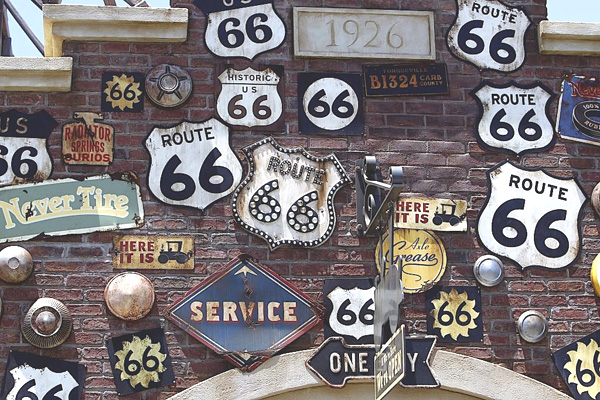Continued from Part 1
1950’s: Postwar Boom
As automobile and truck traffic increased, the businesses along U.S. Route 66 served the travelers’ needs. Service stations, restaurants, auto camps and cottages, later motels, sprang up, some of them in the most astonishing architectural styles – restaurants in the form of a Mexican sombrero or Indian teepees, or with striking neon lights, gift shops fronted by outer-space creatures or dinosaurs. All this became part of the scene and for many years have been copied around the country. From the end of World War II up to 1956, the number of motorcycles driven rose from 98,000 to 500,000. During this time many motorcycle clubs were formed, including the Hell’s Angels. The trucking industry also boomed during those years, hurting railroad transportation and becoming the backbone of our economic infrastructure.
1960’s: Nostalgia
Increasing time for leisure, and thus vacations by car, resulted in a romanticizing of the old route, especially through the T.V. series “Route 66” (which ran from 1960 to 1964). Since then, most people refer to the road as “Route 66” rather than U.S. 66. To this day, being ‘on the road’ still is essential to Americans’ sense of freedom. The Interstate highway system was established in 1956. Through the 1960s, construction of this system began to bypass the original U.S. Highway 66 and alignments of the road changed over the years, with the final segment at Williams, Arizona succumbing to I-40 in 1984.
The many comforts we take for granted as we travel today were firmly established during the heyday of Route 66. Like accommodations (motels, campgrounds) and the ease of finding directions (marked highways, exits, traffic signals), the infrastructure to support our machines (tire shops, gas stations, truck stops) and the fact that roads have pavement (no more dirt roads, or ruts through the mud) and even the ubiquitous curio stores.
“We’ll go on forever, Pa, ‘cuz we’re the people”
Ma Joad in “The Grapes of Wrath”, 1939
